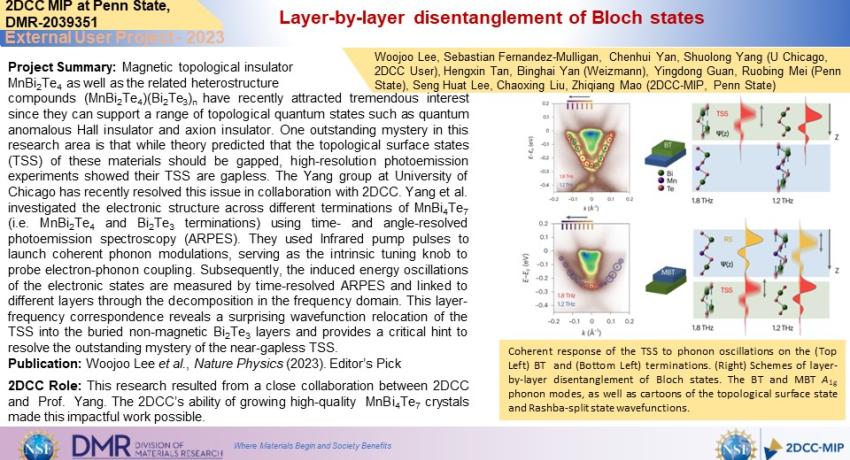MnBi2Te4 as well as the related heterostructure compounds (MnBi2Te4)(Bi2Te3)n have recently attracted tremendous interest since they can support a range of topological quantum states such as quantum anomalous Hall insulator and axion insulator. One outstanding mystery in this research area is that while theory predicted that the topological surface states (TSS) of these materials should be gapped, high-resolution photoemission experiments showed their TSS are gapless. The Yang group at University of Chicago has recently resolved this issue in collaboration with 2DCC. Yang et al. investigated the electronic structure across different terminations of MnBi4Te7 (i.e. MnBi2Te4 and Bi2Te3 terminations) using time- and angle-resolved photoemission spectroscopy (ARPES). They used Infrared pump pulses to launch coherent phonon modulations, serving as the intrinsic tuning knob to probe electron-phonon coupling. Subsequently, the induced energy oscillations of the electronic states are measured by time-resolved ARPES and linked to different layers through the decomposition in the frequency domain. This layer-frequency correspondence reveals a surprising wavefunction relocation of the TSS into the buried non-magnetic Bi2Te3 layers and provides a critical hint to resolve the outstanding mystery of the near-gapless TSS.
2DCC Role: This research resulted from a close collaboration between 2DCC and Prof. Yang. The 2DCC’s ability of growing high-quality MnBi4Te7 crystals made this impactful work possible.
What Has Been Achieved: This work unveiled, for the first time, the surprising wavefunction relocation of the topological surface state from the top magnetic layer (MnBi2Te4) to the buried nonmagnetic layer (Bi2Te3) by time- and angle-resolved photoemission spectroscopy. This experiment directly resolves the outstanding mystery of gapless surface states in the MnBi2nTe3n+1 materials, and paves the road towards the future realization of high temperature quantum anomalous Hall insulators and axion insulators.
Importance of the Achievement: This work is one of the first milestones in ultrafast spectroscopy connecting the spatial and frequency domains, conceptualized as ‘seeing by listening’.
Unique Feature(s) of the MIP that Enabled this Achievement: Synthesis of high-quality MnBi4Te7 single crystals are extremely challenging due to the disorders caused by its non-stoichiometry compositions. The 2DCC has developed a protocol to grow MnBi4Te7 single crystals with good quality. The close collaboration between the user and the 2DCC synthesis enables this work.
Publication (Editor's Pick): Woojoo Lee, Sebastian Fernandez-Mulligan, Hengxin Tan, Chenhui Yan, Yingdong Guan, Seng Huat Lee, Ruobing Mei, Chaoxing Liu, Binghai Yan, Zhiqiang Mao & Shuolong Yang, “Layer-by-layer disentanglement of Bloch states” Nature Physics (2023). https://doi.org/10.1038/s41567-023-02008-4.
Acknowledgments: We acknowledge very helpful discussions with J. Sobota and P. Kirchmann from SLAC National Accelerator Laboratory, and with S. King, J. Park, P. Littlewood and S. Guha from the University of Chicago. The optimization of the static µ-ARPES set-up was partially supported by the US National Science Foundation (NSF) through grant no. DMR-2145373. The trARPES work was supported by the US Department of Energy (grant no. DE-SC0022960). The financial support for a part of sample preparation by S.H.L. was provided by the NSF through the Penn State 2D Crystal Consortium-Materials Innovation Platform (2DCC-MIP) under NSF cooperative agreement DMR-2039351. The sample synthesis efforts by Y.G. were supported by the US Department of Energy under grant DE-SC0019068. C.L. and R.M. acknowledge support from the Penn State MRSEC Center for Nanoscale Science through NSF grant no. DMR-2011839. B.Y. acknowledges financial support by the European Research Council under the European Union’s Horizon 2020 research and innovation programme (grant no. 815869).
